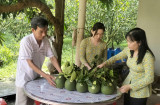Export sector: Proactive adaptation towards higher value
Since early this year, production and import-export activities in the province have achieved positive results. The business community is striving to maintain traditional export markets, expand into new markets and maximize the benefits of new-generation free trade agreements (FTAs) to ensure the completion of the 2024 plan, creating momentum for stable development in the following years.
Positive results
In the first nine months of 2024, the province's GRDP growth rate reached about 7.05% while State budget revenue reached 70% of the adjusted estimate assigned by provincial People's Council and 77% of the estimate assigned by the Prime Minister for 2024, an increase of 14% compared to the same period in 2023. The province's export turnover was estimated at US$ 25.623 billion, an increase of 13.7% while import turnover was estimated at 18.201 billion USD, an increase of 13.4% compared to the same period in 2023. These results show positive signs for the local economy.

Production activities at PANKO VINA Co., Ltd. in My Phuoc I Industrial Park
Tran Hung Dao, Deputy General Director of Foster Electronics Vietnam Co., Ltd. said that in 2024, the company’s export volume is expected to increase by 40% compared to 2023. Currently, the company is actively preparing resources and budget to integrate ecosystems within Japan’s Foster Group to develop new software technologies. Especially in the era of Industry 4.0, the company is planning to shift production fields, adopt new technologies and create new products to meet current market demand.
Pham Van Xo, Chairman of Binh Duong provincial Import-Export Association noted that export-import activities of businesses in the province are trending positively. In the first nine months of 2024, export growth of businesses reached 15%-20% compared to the same period in 2023. If businesses can maintain the current growth rate, Binh Duong’s export turnover in 2024 will reach a new milestone. “Recently, many orders have returned, supporting production until the end of 2024 and into the following years. This is a good sign for export activities in the last months of the year. However, for stable and sustainable export activities, businesses’ products must ensure quality, have a brand and maintain market reputation”, said Mr. Xo.
Flexible solutions
Regarding the potential and opportunities for timber and wooden product exports in the last months of the year, Nguyen Liem, Chairman of Binh Duong Furniture Association (BIFA) believes that the U.S is taking steps to cut interest rates. This will inevitably stimulate consumer demand, expanding the demand for imports and exports from businesses, leading to a strong increase in demand for wooden products in this market. In addition, in July, the U.S. Department of Commerce issued the final conclusion of its investigation into anti-dumping and countervailing duties on wooden cabinets imported from Vietnam, canceling the investigation. This move opens up greater access for Vietnamese wood products to the U.S. market, allowing for significant growth in the near future.
However, according to Mr. Liem, for sustainable growth, the wood industry must proactively adapt to all conditions and circumstances, making flexible adjustments in both production and export processes. Especially, the sector needs to develop technologies and supply chains, from raw materials to logistics.
In reality, although Binh Duong’s timber and wood product exports accounted for 42% of the country's total export turnover in this sector in the first nine months of 2024, challenges remain. Short order times, rising raw material costs and customers demanding lower prices are creating pressure. Additionally, delayed payments from partners, new environmental requirements, emission reduction targets and green production standards are significant challenges, especially for small and medium enterprises (SMEs) in the wood industry.
For the textile and garment industry, despite many businesses having orders until the end of 2024, they are facing fierce competition in the market. To enhance competitiveness and increase exports, higher value must be created for products. Businesses need to avoid producing goods that other countries can easily replicate. They must focus on enhancing product competitiveness, proactively promoting trade, improving management, upgrading technologies and reducing production costs. Moreover, companies must take effective steps to reduce emissions towards net zero emissions.
Reported by Tieu My-Translated by Kim Tin
 Vietnam balances supply and demand to prepare for Tet shopping season
Vietnam balances supply and demand to prepare for Tet shopping season
 Developing Bac Tan Uyen district into a town in the period 2030-2040
Developing Bac Tan Uyen district into a town in the period 2030-2040
 Accompanying investors for sustainable development
Accompanying investors for sustainable development
 Tan Uyen: Flexible adaptation, stable growth
Tan Uyen: Flexible adaptation, stable growth
 Tax revenue management boosted and modernized
Tax revenue management boosted and modernized
 To build synchronous infrastructure, facilitate new era development
To build synchronous infrastructure, facilitate new era development
 Bau Bang aims to become a center of innovation and industry
Bau Bang aims to become a center of innovation and industry
 Processing and manufacturing industry makes high efforts, gains good growth
Processing and manufacturing industry makes high efforts, gains good growth
 Enterprises assisted to enhance product quality and elevate competitiveness
Enterprises assisted to enhance product quality and elevate competitiveness
 Processing and manufacturing industry accounts for over 91% of foreign investment capital
Processing and manufacturing industry accounts for over 91% of foreign investment capital






